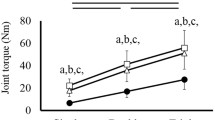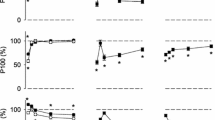Summary
Electrically evoked twitch properties of the human plantarflexor muscles were measured with the muscles at a constant length (static) and during passive shortening and lengthening. A Kin-Com dynamometer system was used to passively move the ankle joint at 0.52 rad s−1 (30‡ s−1), as well as to record the twitch responses which were elicited by supramaximal electric shocks applied over the tibial nerve in the popliteal fossa. In the lengthening and shortening conditions, twitches were evoked by triggering the shocks so that the twitch response occurred at a similar angular position for all three conditions. The lengthening twitch peak torque was about twice as large as that recorded for the shortening condition. There was, however, no statistical difference in the twitch time course in these three testing conditions. This twofold increase in the peak twitch torque during lengthening, compared to shortening, is much greater than the torque increase reported during eccentric, as compared to concentric maximal voluntary contractions. These findings suggest that a deactivation process of the contractile system occurs during muscle shortening, while in contrast, during passive lengthening a potentiation mechanism is acting, and that both these mechanisms are independent of volitional muscle activation. The present study is the first to demonstrate the possibility of electrically evoked contractions of human muscles during passive lengthening and shortening. We believe that the use of such evoked contractions may be promising for the study of contractile behaviour of human skeletal muscles during eccentric and concentric conditions.
Similar content being viewed by others
References
Asthon TEJ, Singh M (1975) Relationship between erectores spinae voltage and back-lift strength for isometric, concentric and eccentric contractions. Res Quart 46: 282–286
Asmussen E, Hansen O, Lammert O (1965) The relation between isometric and dynamic muscle strength in man. Communications from the testing and observation institute of the Danish National Association for Infantile Paralysis. No 20
Bélanger AY, McComas AJ (1981) Extent of motor unit activation during effort. J Appl Physiol: Respirat Environ Exercise Physiol 51: 1131–1135
Bélanger AY, McComas AJ, Elder GBC (1983) Physiological properties of two antagonistic human muscle groups. Eur J Appl Physiol 51: 381–393
Carlson FD, Wilkie DR (1974) Muscle Physiology. Englewood Cliffs, New Jersey
Close RI (1972) Dynamic properties of mammalian skeletal muscle. Physiol Rev 52: 129–197
Doss WS, Karpovich PV (1965) A comparison of eccentric, concentric and isometric strength of elbow flexors. J Appl Physiol 20: 351–353
Edman KAP (1975) Mechanical deactivation induced by active shortening in isolated muscle fibres of the frog. J Physiol 246: 255–275
Edman KAP (1980) Depression of mechanical performance by active shortening during twitch and tetanus of vertebrate muscle fibres. Acta Physiol Scand 109: 15–26
Edman KAP, Elzinga G, Noble MIM (1978) Enhancement of mechanical performance by stretch during tetanic contractions of vertebrate skeletal muscle fibres. J Physiol 281: 139–155
Edwards RHT, Hill DK, Jones DA (1975) Heat production and chemical changes during isometric contractions of the human quadriceps. J Physiol 251: 303–315
Farrel M, Richards JG (1986) Analysis of the reliability and validity of the kinetic communicator exercise device. Med Sci Sport Exerc 18: 44–49
Gravel D, Bélanger AY, Richards CL, Filion M (1985) Twitch properties of human muscle during passive shortening and lengthening. Soc Neurosci (Abstr) 11: 406
Hill AV (1964) The variation of total heat production in a twitch with velocity of shortening. Proc R Soc Lond Ser B 159: 596–605
Ikai M, Steinhaus AH (1961) Some factors modifying the expression of human strength. J Appl Physiol 16: 157–163
Joyce GC, Rack PMH, Westbury DR (1969) The mechanical properties of cat soleus muscle during controlled lengthening and shortening movements. J Physiol 204: 461–474
Katz B (1939) The relation between force and speed in muscular contraction. J Physiol 96: 45–64
Komi PV, Buskirk ER (1972) Effect of eccentric and concentric muscle conditioning on tension and electrical activity of human muscle. Ergonomics 15: 417–434
Kramer JF (1986) Effect of electrical stimulation frequencies on isometric knee extension torque. Phys Ther 67: 31–38
Levin A, Wyman J (1927) The viscous elastic properties of muscle. Proc R Soc Lond Ser B 101: 218–243
Marsh E, Sale D, McComas AJ, Quinlan J (1981) Influence of joint position on ankle dorsiflexion in humans. J Appl Physiol: Respirat Environ Exercise Physiol 51: 160–167
Olson VL, Smidt GL, Johnston RC (1972) The maximum torque generated by the eccentric, isometric and concentric contractions of the hip abductor muscles. Phys Ther 52: 149–157
Rodgers KL, Berger RA (1974) Motor unit involvement and tension during maximum voluntary concentric, eccentric, and isometric contractions of the elbow flexors. Med Sci Sports 6: 253–259
Sale D, Quinlan J, Marsh E, McComas AJ, Bélanger AY (1982) Influence of joint position on ankle plantarflexion in humans. J Appl Physiol: Respirat Environ Exercise Physiol 52: 1636–1642
Selinger V, Dolejs L, Karas V (1980) A dynamometric comparison of maximum eccentric, concentric, and isometric contractions using EMG and energy expenditure measurements. Eur J Appl Physiol 45: 235–244
Wickiewick TL, Roy RR, Powell PL, Perrine JJ, Edgerton VR (1984) Muscle architecture and force-velocity relationships in humans. J Appl Physiol: Respirat Environ Exercise Physiol 57: 435–443
Author information
Authors and Affiliations
Additional information
This work was supported by a grant from l'Institut de Recherche en Santé et en Sécurite du Travail du Québec (IRSST)
Rights and permissions
About this article
Cite this article
Gravel, D., Bélanger, A.Y. & Richards, C.L. Study of human muscle contraction using electrically evoked twitch responses during passive shortening and lengthening movements. Europ. J. Appl. Physiol. 56, 623–627 (1987). https://doi.org/10.1007/BF00424800
Accepted:
Issue Date:
DOI: https://doi.org/10.1007/BF00424800




